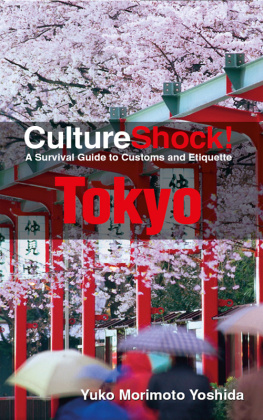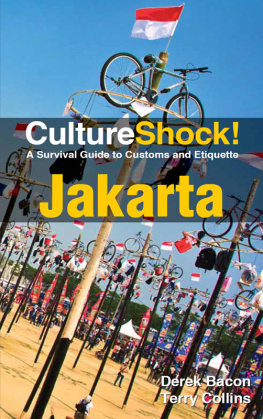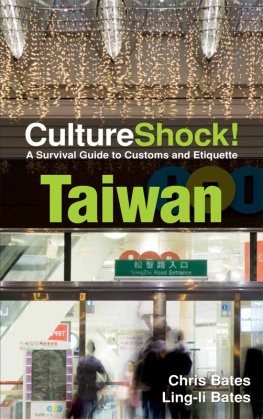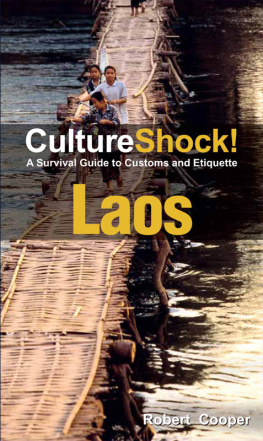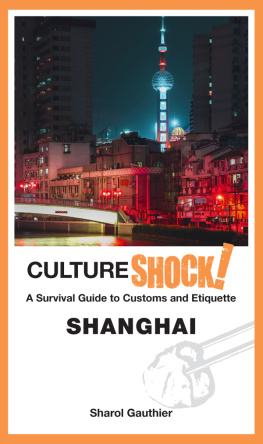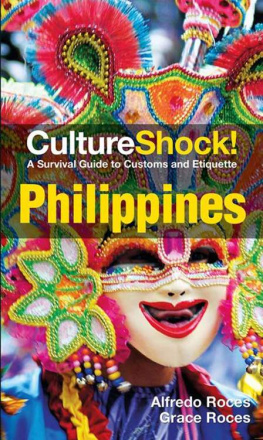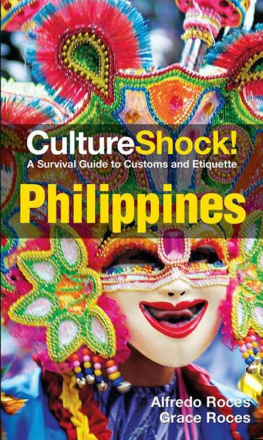Yuko Morimoto Yoshida - Culture Shock! Tokyo: A Survival Guide to Customs and Etiquette
Here you can read online Yuko Morimoto Yoshida - Culture Shock! Tokyo: A Survival Guide to Customs and Etiquette full text of the book (entire story) in english for free. Download pdf and epub, get meaning, cover and reviews about this ebook. year: 2008, publisher: Cavendish Square Publishing, genre: Politics. Description of the work, (preface) as well as reviews are available. Best literature library LitArk.com created for fans of good reading and offers a wide selection of genres:
Romance novel
Science fiction
Adventure
Detective
Science
History
Home and family
Prose
Art
Politics
Computer
Non-fiction
Religion
Business
Children
Humor
Choose a favorite category and find really read worthwhile books. Enjoy immersion in the world of imagination, feel the emotions of the characters or learn something new for yourself, make an fascinating discovery.
- Book:Culture Shock! Tokyo: A Survival Guide to Customs and Etiquette
- Author:
- Publisher:Cavendish Square Publishing
- Genre:
- Year:2008
- Rating:3 / 5
- Favourites:Add to favourites
- Your mark:
- 60
- 1
- 2
- 3
- 4
- 5
Culture Shock! Tokyo: A Survival Guide to Customs and Etiquette: summary, description and annotation
We offer to read an annotation, description, summary or preface (depends on what the author of the book "Culture Shock! Tokyo: A Survival Guide to Customs and Etiquette" wrote himself). If you haven't found the necessary information about the book — write in the comments, we will try to find it.
A Survival Guide to Customs and Etiquette
Culture Shock! Tokyo: A Survival Guide to Customs and Etiquette — read online for free the complete book (whole text) full work
Below is the text of the book, divided by pages. System saving the place of the last page read, allows you to conveniently read the book "Culture Shock! Tokyo: A Survival Guide to Customs and Etiquette" online for free, without having to search again every time where you left off. Put a bookmark, and you can go to the page where you finished reading at any time.
Font size:
Interval:
Bookmark:

This edition published in 2008 by:
Marshall Cavendish Corporation
99 White Plains Road
Tarrytown, NY 10591-9001
www.marshallcavendish.us
2003 Times Media Private Limited
2005, 2008 Marshall Cavendish International (Asia) Private Limited
All rights reserved
No part of this publication may be reproduced, stored in a retrieval system or transmitted, in any form or by any means, electronic, mechanical, photocopying, recording or otherwise, without the prior permission of the copyright owner. Request for permission should be addressed to the Publisher, Marshall Cavendish International (Asia) Private Limited, 1 New Industrial Road, Singapore 536196. Tel: (65) 6213 9300, fax: (65) 6285 4871. E-mail:
The publisher makes no representation or warranties with respect to the contents of this book, and specifically disclaims any implied warranties or merchantability or fitness for any particular purpose, and shall in no event be liable for any loss of profit or any other commercial damage, including but not limited to special, incidental, consequential, or other damages.
Other Marshall Cavendish Offices:
Marshall Cavendish International (Asia) Private Limited. 1 New Industrial Road, Singapore 536196  Marshall Cavendish Ltd. 5th Floor, 3238 Saffron Hill, London EC1N 8FH, UK
Marshall Cavendish Ltd. 5th Floor, 3238 Saffron Hill, London EC1N 8FH, UK  Marshall Cavendish International (Thailand) Co Ltd. 253 Asoke, 12th Flr, Sukhumvit 21 Road, Klongtoey Nua, Wattana, Bangkok 10110, Thailand
Marshall Cavendish International (Thailand) Co Ltd. 253 Asoke, 12th Flr, Sukhumvit 21 Road, Klongtoey Nua, Wattana, Bangkok 10110, Thailand  Marshall Cavendish (Malaysia) Sdn Bhd, Times Subang, Lot 46, Subang Hi-Tech Industrial Park, Batu Tiga, 40000 Shah Alam, Selangor Darul Ehsan, Malaysia
Marshall Cavendish (Malaysia) Sdn Bhd, Times Subang, Lot 46, Subang Hi-Tech Industrial Park, Batu Tiga, 40000 Shah Alam, Selangor Darul Ehsan, Malaysia
Marshall Cavendish is a trademark of Times Publishing Limited
ISBN 10: 0-7614-5502-7
eISBN : 978 981 4435 91 8
Please contact the publisher for the Library of Congress catalog number
Printed in China by Everbest Printing Co Ltd
Photo Credits:
All black and white photos from the author except page xii (Corel Stock Photo Library), page 13 (Japan Tourism Bureau).
Colour photos from Getty Images pages a, i, jk; Photolibrary pages bc, de, fg, h, lm, no, p  Cover photo: Corbis
Cover photo: Corbis
All illustrations by TRIGG
Culture shock is a state of disorientation that can come over anyone who has been thrust into unknown surroundings, away from ones comfort zone. CultureShock! is a series of trusted and reputed guides which has, for decades, been helping expatriates and long-term visitors to cushion the impact of culture shock whenever they move to a new country.
Written by people who have lived in the country and experienced culture shock themselves, the authors share all the information necessary for anyone to cope with these feelings of disorientation more effectively. The guides are written in a style that is easy to read and covers a range of topics that will arm readers with enough advice, hints and tips to make their lives as normal as possible again.
Each book is structured in the same manner. It begins with the first impressions that visitors will have of that city or country. To understand a culture, one must first understand the peoplewhere they came from, who they are, the values and traditions they live by, as well as their customs and etiquette. This is covered in the first half of the book.
Then on with the practical aspectshow to settle in with the greatest of ease. Authors walk readers through how to find accommodation, get the utilities and telecommunications up and running, enrol the children in school and keep in the pink of health. But thats not all. Once the essentials are out of the way, venture out and try the food, enjoy more of the culture and travel to other areas. Then be immersed in the language of the country before discovering more about the business side of things.
To round off, snippets of basic information are offered before readers are tested on customs and etiquette of the country. Useful words and phrases, a comprehensive resource guide and list of books for further research are also included for easy reference.
Tokyo is a place of continuous renewal. Its landscape has been altered several times during the course of its history by fire, war, or natural disasterbut the people of Tokyo (Tokyoites) have turned each occasion into an opportunity for rebirth, and the metropolis has bounced back bigger and better than before. Even during the two centuries when Japan was technically closed off to foreigners and travel within the country was somewhat restricted, people of the capital eagerly adopted new trends in thought, technology and fashion to which they were exposed. Today, Tokyoites are still attentive to changing trends and eager to latch onto them. To fall behind would be unbearable. However, they are apt to grow weary of new trends quickly and constantly seek new targets for their attention.
What are the origins of this ability to recover from adversity and this appetite and passion for things new? Perhaps they come from deep within ancient Japanese traditions. Shinto, the countrys indigenous belief system, offers the idea that destruction and rebuilding are rites of purification, like a cleansing of the soul. Buddhism, a religion introduced to Japan from China, offers the idea that life is transitory, so people should not get too attached to the things of everyday life. To this day, Tokyoites appreciate traditional but fleeting seasonal events, and participate in a variety of rituals and celebrations with ancient rootsall with the latest technical gadgets tucked away in their pockets.
This contradicting, unique character of the society can be better experienced by people who live in Tokyo than by those who simply visit the city. Residents can easily see what is the leading trend. People dress according to the latest fashion style; in restaurants and entertainment spots come and go; the latest electronic gadgets rapidly sell off the shelves; popular actors and actresses appear in every magazine and television show. When one trend changes, everyone shifts to the new one. At the same time, enjoyment of seasonal events gives rhythm to peoples lives and participation in traditional rituals and celebrations connects them with the past. In time, newcomers learn to appreciate both the subtle and not-so-subtle contrasts of this ambivalent culture; this appreciation is a sure sign that Tokyo has become home.
As you read through this book, please note the following:
 Throughout the book, Japanese words are written in romaji (Japanese words transcribed into the English alphabet; also known as romanisation).
Throughout the book, Japanese words are written in romaji (Japanese words transcribed into the English alphabet; also known as romanisation).
 The prices mentioned in this book are estimates and are generally stated in Japanese yen.
The prices mentioned in this book are estimates and are generally stated in Japanese yen.
 Many of the resources listed in this book include website addresses, all of which have English language pages. If you go to these websites and encounter a Japanese language home page, though, please be patientlook for a little icon that says English and click on it.
Many of the resources listed in this book include website addresses, all of which have English language pages. If you go to these websites and encounter a Japanese language home page, though, please be patientlook for a little icon that says English and click on it.
Every effort has been made to ascertain that the information in this book is accurate; my apologies if you find that places and websites mentioned have changed or disappeared. This is just a fact of life in this ever-changing metropolis that is at the same time very international and Japanese.
Next pageFont size:
Interval:
Bookmark:
Similar books «Culture Shock! Tokyo: A Survival Guide to Customs and Etiquette»
Look at similar books to Culture Shock! Tokyo: A Survival Guide to Customs and Etiquette. We have selected literature similar in name and meaning in the hope of providing readers with more options to find new, interesting, not yet read works.
Discussion, reviews of the book Culture Shock! Tokyo: A Survival Guide to Customs and Etiquette and just readers' own opinions. Leave your comments, write what you think about the work, its meaning or the main characters. Specify what exactly you liked and what you didn't like, and why you think so.

